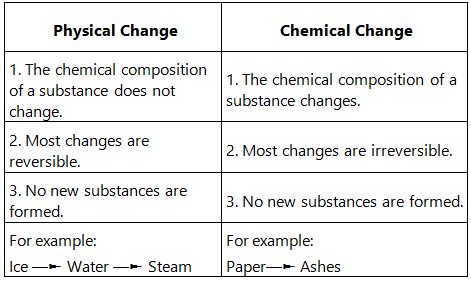Class 7 Exam > Class 7 Notes > NCERT Textbooks & Solutions for Class 7 > NCERT Summary: Physical & Chemical Changes
Physical & Chemical Changes Summary Class 7 NCERT Summary
Types of Changes
- Changes can broadly be classified into two types − physical and chemical.
Physical Change
- Properties such as shape, size, colour and state of a substance are called its physical properties.
- A physical change in which a substance undergoes a change in its physical properties is called a physical change.
Chemical Change
- A change in which one or more new substances are formed is called a chemical change.
- A chemical change in which a substance undergoes a change in its chemical properties is called a chemical change.
Burning of Magnesium Ribbon
- Magnesium ribbon burns with a brilliant white and leaves behind a powdery ash when completely burnt.
Magnesium (Mg) + Oxygen (O2) → Magnesium oxide (MgO)
Dissolving magnesium ash in water
Magnesium oxide (MgO) + Water (H2O) → Magnesium hydroxide [Mg(OH)2]
Difference between Physical and Chemical Change

- Burning a candle is a combination of physical and chemical change.
Copper Sulphate Chemical Reaction
- When copper sulphate reacts with iron, the colour of the solution changes from blue to green due to the formation of iron sulphate.
- Copper Sulphate solution (blue) + Iron → Iron Sulphate solution (green) + Copper (brown deposit)
Rusting

- Rusting is an example of chemical change.
Iron (Fe) + Oxygen (O2, from the air) + water (H2O) → rust (iron oxide Fe2O3) - Presence of both air and water is essential for rusting to take place.
- Rusting can be prevented by cutting the contact of either air or water or both with iron.
Protection from Rusting
- The same can be done by greasing, oiling, painting, and galvanizing iron.
- The process of depositing a layer of zinc on iron is called galvanization.
- Rusting can also be checked by alloying iron with other elements. Stainless steel is an alloy of iron with carbon, chromium, nickel, and manganese.
Crystallization
- Crystallization is an example of physical change. The process of crystallization is used for purification of some substances.

The document Physical & Chemical Changes Summary Class 7 NCERT Summary is a part of the Class 7 Course NCERT Textbooks & Solutions for Class 7.
All you need of Class 7 at this link: Class 7
FAQs on Physical & Chemical Changes Summary Class 7 NCERT Summary
| 1. What is a physical change? |  |
Ans. A physical change is a type of change in which the form or appearance of a substance is altered, but its chemical composition remains the same. Examples of physical changes include melting ice, boiling water, and tearing a piece of paper.
| 2. What is a chemical change? |  |
Ans. A chemical change, also known as a chemical reaction, is a process where one or more substances are transformed into new substances with different chemical properties. During a chemical change, the composition of the substances involved is altered. Examples of chemical changes include burning wood, rusting of iron, and digestion of food.
| 3. What are some differences between physical and chemical changes? |  |
Ans. Some differences between physical and chemical changes include:
- Physical changes only affect the physical properties of a substance, such as its shape, size, or state of matter, while chemical changes involve the formation of new substances.
- In physical changes, the original substances can be easily reversed back to their original form, whereas in chemical changes, the original substances cannot be easily obtained again.
- Physical changes do not involve the breaking or formation of chemical bonds, while chemical changes do.
- Physical changes generally do not produce energy, while chemical changes often involve the release or absorption of energy.
| 4. What are some examples of physical changes? |  |
Ans. Some examples of physical changes include:
- Melting of ice: When ice melts, it changes from a solid to a liquid state without any change in its chemical composition.
- Boiling water: When water is heated, it changes from a liquid to a gaseous state without any change in its chemical composition.
- Crushing a can: When a can is crushed, its shape changes, but the material remains the same.
| 5. What are some examples of chemical changes? |  |
Ans. Some examples of chemical changes include:
- Burning wood: When wood is burned, it undergoes a chemical reaction with oxygen in the air, producing carbon dioxide, water vapor, and ash.
- Digestion of food: When food is digested in our body, it undergoes a series of chemical reactions to break down complex molecules into simpler ones that can be absorbed and utilized by our cells.
- Rusting of iron: When iron is exposed to oxygen and moisture, it undergoes a chemical reaction that forms iron oxide, commonly known as rust.
Related Searches

















